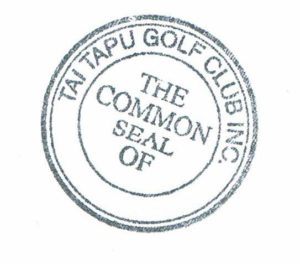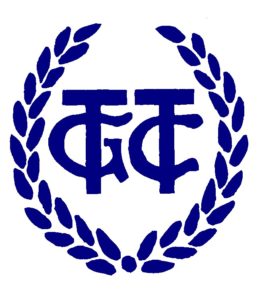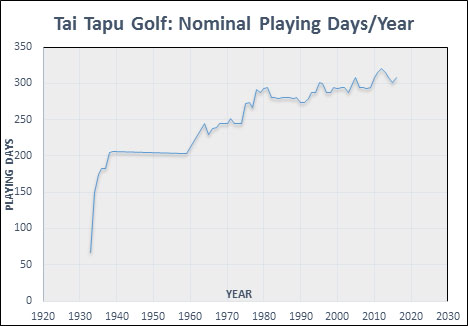Design and General Appearance of Programme Booklets
The annual programme booklet of golf clubs is basically simple. It has pages, invariably white and of ordinary photocopy paper or equivalent, stapled in place between covers of folded light card. The card is usually coloured. Neither the card nor the pages are of glossy smooth texture. The front cover carries the golf club’s name in a header and its logo or similar image, the names and contacts of the club’s officers and committees. The internal pages present the programme for the year in various ways, club notices, advertisements, blank or ruled pages, local rules of the club etc. And that’s it—a strictly utilitarian document, and it could remain the same year after year.
But the Tai Tapu Golf booklets have not remained the same and improvements have occurred. Centrally improvements have depended upon printing technology of the time and always the desire is for bright cheerful colour. But colour does not come cheaply and most of Tai Tapu’s programme booklets covers have used “economy?? folded coloured card. This card is absorbent and not conducive to sharpness. Ideally the dominating colour should change each season so that members are aware of which is the current booklet. Thus a good colour combination, once found –yes, black print on yellow is perfect–couldn’t really be used every season.
All the booklets up to and including 2008 have had the front over covered only with text. All very neat but uninspiring. Starting in 2009, the policy has been to show images of significant events at the Club on the front cover. That for 2009 shows the players in the first event of the 2008 75th Jubilee of the Club, 2010 showed an aerial view of the course taken from a balloon, 2011 illustrated clubhouse/balcony improvements, 2012 showed a group of volunteers working on the course.
But these images all failed. Sharp clear images could not be obtained on a monochrome colour scale. However, to coin a phrase, “A great leap forward?? was achieved by the new Club Secretary when he designed the covers for the 2014 programme booklet (and also for 2015, 2016). The covers were of smooth clean white card and printed on this with up-to-date printing processes achieved a fine result. The 2014 booklet featured another aerial image of the course, that for 2015 showed the clubhouse with its new roof cladding, and 2016 the new ponding at fairway #4 with its windmill feature. This image improvement extended also to mugshots of convenors of playing groups on the internal pages of the booklets. Nonetheless, we wonder whether a central block of colour pages would be not unjustified for pictures of officials and committees as there is a dearth of official pictures of committees in the clubhouse.
Booklet Dimensions The height and width of all booklets in the collection were measured on their front covers. The height and width of the 1959 card, 120 x 75 mm, are different from all others. It is simply a piece of folded card. It would be reasonable to suppose that there is nothing that could be simpler and that cards earlier than 1959 and possibly 1960-1963, were of a similar size. The dimensions of all other booklets in the collection are surprisingly similar. For the years 1964 through 1989 their average heights and widths were 145.4 mm x 83.4mm. We could not identify a standard paper size that would fit those dimensions. However, the booklets from 1991 to present (2016) averaged 147.8mm x 99.8 mm, which is close to the A6 standard paper size.
Numbers of Pages in Programme Booklets
Note: Just to be clear, we distinguish between a leaf and a page. A single sheet within a book is a leaf, and each side of a leafis a page. When numbering pages in a book, all right hand pages carry odd numbers (1,3,5, etc.) and all left hand pages carry, obviously, even numbers. We refer to the front and back covers of booklets separately from the leaves and pages.
While we do not claim special knowledge about printing processes, we do know that books are not printed page by page. They are instead set out with multiple pages on a larger sheet which is subsequently cut and folded to allow (usually) 4 pages per smaller sheet that fits into the booklet with centre staples. So the total pages in a booklet such as ours will usually be found as a multiple of 4.
Total Pages in Programme Booklets
| Decade | 1964-1969 | 1970-79 | 1980-89 | 1990-99 | 2000-09 | 2010-2016 |
| Average Total Pages | 4 | 13 | 25 | 46 | 49 | 50 |
| Range Total Pages | All 4 | 8 to 24 | 12 to 36 | 20 to 52 | 48 to 64 | 48-52* |
*Excluding anomalous 2010 which had 92 pages.
As shown in the table, the average numbers of pages over the decades listed increased markedly from the 1960s through to the 1990s, and then appeared to have stabilised. What caused the increases? First it seems that there was an attempt—successful in the day—to improve the quality of the booklets with attractive covers and larger print fonts. There was also a move towards inserting information which should really have been there in the first place—such as notes on golfing etiquette, course rules and a list of the Club’s trophies.
Inclusion of Canterbury Golf Organisations
However, a more substantial increase was occasioned by the inclusion from 1963 of lists, provided by The Canterbury Provincial Golf Association, of golfing events These included Ladies Open Days at all Clubs which were members of the Association, and Clubs’ Official Tournaments—for example the Tai Tapu Golf Club’s open tournaments. During the period 1964-1969 there was an average 2.7 pages in the programme booklet of Canterbury Provincial Golf tournament listings. For the 1970s, the pages so devoted had increased to an average 3.5. In the 1980s the average was about 6.0 and in the 1990s and into the new century 10.2 and 10.8 equivalent pages. But at the same time inclusion of similar material about Canterbury Central Golf interclub programmes had raised some issues. Such material had first appeared in the 1986 programme booklet and took up some 4 pages then, and varying from 2 to 4 pages each season until 2008. It was noted that the Central Canterbury schedule rarely could be adhered to because inevitably there were postponements due to wet weather and course closures. It was found that communications in Central Canterbury Golf adequately dealt with maintaining or amending the schedule In 2008, the inclusion of all the Canterbury Golf Inc. data was critically reviewed, the central issue was why take so much space in our Club’s annual programme booklet for information which few of our members had ever used. The decision was then taken for the 2009 booklet to omit such material, including also the Central Canterbury schedules. Somewhat contrarily the issue was re-visited for the 2010 booklet and all the Canterbury and Canterbury Central Golf was re-inserted in fine print. But further, there was a call for all the Tai Tapu playing groups schedules to be combined as an overall calendar. Eventually, after the foregoing and several “Notes?? pages, the 2010 booklet finished with 92 pages.
Inclusion of Advertisements.
Few, if any publications these days are produced without commercial advertising—indeed the world of magazines and newsprint is sustained by commercial advertising. For the Tai Tapu Golf Club a conservative policy was in effect until 1978 as the Club could apparently comfortably pay for the annual programme booklets. That policy was abandoned thenceforth and the 1979 programme booklet carried 11 individual advertisements of either half or full page size. Every programme booklet since has carried advertisements, varying in number from as many as 19 in 2010 to a low 5 in 1994, and an average of 11.3. A casual scan through the advertisements reveals that virtually all are for commercial activities with which a Tai Tapu Golf Club member is associated. The reminder appear to be from companies which are suppliers to Tai Tapu Golf Club (such as Tai Tapu Mower & Hire Centre, New World Supermarket, Halswell). Thus the advertisements are mutually to the advantage of the Club and the advertiser. Some advertisements are in effect a “thank-you?? to a charitable organisation (such as Air Rescue Services Ltd) which has made a grant to the Club.
Inclusion of Normal Golf Club Information: Winners of Events in the Previous Season.
Somewhat strangely, lists of the winners of trophies in the previous season did not appear in any booklet until the 1995 issue provided the winners from 1994. Even more strangely, for the subsequent 11 booklets, the men’s results were spread over a greater area per trophy item than for the Ladies results. The worst example would be that of the 2006 booklet in which are presented the 2005 Men’s results at 1.94 items/vertical-cm and the 2005 Ladies’ results at 3.9 items/vertical-cm. That anomaly was corrected for the 2006 booklet.
Inclusion of Programme and Results for the Wednesday Group (now the Mid-Week Group)
Their programme did not appear in the Club’s booklet until 2006 and their Trophy results until 2010. (See Short History of the Mid-Week Group)
Sunday Golf Programme and Results
Sunday Mixed Trophy events were treated much the same as the Men’s events in the programme booklets. As members will know, the sad fact is that the numbers of members coming to play in Sunday Mixed Events dwindled away until in 2013(?) the Sunday programme was discontinued indefinitely.
Tai Tapu Golf Logo
It is not known when the Tai Tapu Golf Club logo was designed nor when it was officially adopted—if it ever was. The first document in which the logo appeared was the 1986 edition of the Club Rules. The logo appears on the front cover. However, it is not defined as the official logo in the Rules themselves. There is reference to a common seal but the design or image of such is not contained in the Rules at any time. It was not until the 1995 programme booklet that the logo next appeared. It has been on every programme booklet since. One might have expected that the logo would appear in the Club’s official colours which are in the 2012 Club Rules as any combination of at least two of Jade, Navy Blue and White. Only the booklets 2014, 2015, 2016 have appeared in compliance with Navy Blue logo on a white background. In all the rest the logo has been black. One might speculate that the logo is quite sufficiently distinctive that its colours are immaterial. Indeed, at the 2008 75th Club Jubilee there was a display of the Club logo in a variety of colours.

The Imprint of the Common Seal of Tai Tapu Golf–Time for an upgrade?

Obviously the Current Tai Tapu Golf Logo

Tai Tapu Golf Logo in Various Colours at 2008 75th Jubilee
Golf is a Winter Sport?
This assertion is often made in reference to the seasons when golf is played in Canterbury, if not New Zealand. And indeed it does appear so because golf clubs in NZ each year used to open around February and close around October. One explanation for this might be that it followed the United Kingdome practice, —or more particularly, in Scotland. That Scotland is the home of golf is further emphasised apparently by Jack Nicklaus, who stated is quoted from website promoting Scottish sports http://www.scotland.org/features/scottish-sports that “Scotland is Golf??. However, in the next paragraph on the same website it is stated
“When the winter rolls around and the golf stops, a host of other sports get going as Scotland becomes a Mecca for an ever increasing number of skiers and snowboarders.??
That is to say that golf isn’t a winter sport in Scotland, its acknowledged home. An alternative explanation is that summer in New Zealand is broken in two main parts, before and after Xmas—and effectively loses a large chunk of summer. Be all that as it may, we have extracted from the Programme Booklets (and other sources as well) the official opening and closing dates for organised competition at Tai Tapu Golf each year. [Data are missing between about 1946 and 1959]. The nominal playing days per year are plotted on the graph following. The steady increase from 1960 or so indicates that the leisurely approach to starting the season as late as March or even April and closing early, well before Xmas was a waste of good weather.

Results of previous season’s interclub matches
These results have not been inserted into programme booklets until as recently as 2016 booklet for the 2015 season. And then it was only a brief summary.
Who was the Real Treasurer?
An oddity amongst front cover notices was “Subs may be paid to Hon Treasurer, C/- Ager, Riley, Cocks, PO Box 1234 Christchurch.” That raises the issue as to who was the official treasurer at the time. That note appears on all the booklets from 1966 through 1978 and Derek Terence Ager was a member of Tai Tapu Golf in that period. (Derek Ager is recorded as winning the Waitaha Cup in 1955 and the Men’s Intermediate Championship in 1953.) But our records also show that the Club Treasurer 1965-68 was G R Lethaby; 1969-1975 it was A F Rodgers (except for Rendall in 1972); 1976 it was William Weatherhead; and 1977-1978 it was K G Townshend. (We also know that Derek Ager moved to Auckland in 1978). What role did Derek Ager have then in the Club’s financials? We don’t know and would appreciate receiving some clarification.
Egregious errors
Proofing of programme booklets would seldom have had the services of a proof reader and checking for errors and omissions inevitably failed to fully succeed. Errors in such as of telephone numbers or addresses of officials have therefore been discovered from time to time after booklets were printed. However, it appears that egregious errors occurred on the front covers of the 1985 and 1995 booklets. Hastily, correct versions were printed and pasted on all the front covers.
Honorary Life Members
Also listed from 1959 have been Life Members of which in 1959 there were two, viz., Mr W G Macartney, essentially the Club’s first President and leading light, so an obvious choice, and George Orr Templeton. The practice of appointing Honorary Members–or from about 2010–Honorary Life Members– has continued to the present year (2016). Photographs of all past and present Honorary Life Members are displayed in the Clubhouse lounge. An article on Honorary Life Members is also available on this website.